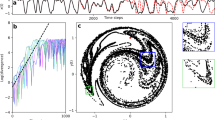Abstract
We report the results of a search for evidence of unstable periodic orbits in the sensory afferents of the facial cold receptors of the rat. Cold receptors are unique in that they exhibit a diversity of action potential firing patterns as well as pronounced transients in firing rate following rapid temperature changes. These characteristics are the result of an internal oscillator operating at the level of the membrane potential. If such oscillators have three or more degree of freedom, and at least one of which also exhibits a nonlinearity, they are potentially capable of complex activity. By detecting the existence of unstable periodic orbits, we demonstrate low-dimensional dynamical behavior whose characteristics depend on the temperature range, impulse pattern, and temperature transients.
Similar content being viewed by others
References
Badii R, Brun E, Finardi M, Flepp L, Holzer R, Parisi J, Reyl C, Simonet J (1994) Progress in the analysis of experimental chaos through periodic orbits. Rev. Mod. Phys. 66: 1389–1415.
Bevington PR (1969) Data Reduction and Error Analysis. McGraw-Hill, New York, pp. 48–49.
Braun HA, Schäfer K, Voigt K, Peters R, Bretschneider F, Pei X, Wilkens L, Moss F (1997) Low-dimensional dynamics in sensory biology 1: Thermally sensitive electroreceptors of the catfish. J. Comp. Neurosci. 4: 335–347.
Braun HA, Wissing H, Schäfer K, Hirsch MC (1994) Oscillation and noise determine signal transduction in shark multimodal sensory cells. Nature 367: 270–273.
Christini D, Collins J (1995) Controlling nonchaotic neuronal noise using chaos control techniques. Phys. Rev. Lett. 75: 2782–2785.
Cvitanovic P (1991) Periodic orbits as the skeleton of classical and quantum chaos. Physica D 51: 138–152.
Dolan K (1997) The statistical occurrence of unstable periodic orbits in noisy chaotic and random systems. Bull. Am. Phys. Soc. 42: 815.
Faure P, Korn H (1997) A nonrandom dynamic component in the synaptic noise of a central neuron. Proc. Natl. Acad. Sci. USA 94: 6506–6511.
Gluckman BJ, Spano ML, Yang W, Ding M, In V, Ditto WL (1997) Tracking unstable periodic orbits in nonstationary highdimensional chaotic systems: Method and experiment. Phys. Rev. E. 55: 4935–4942.
Grassberger P, Procaccia I (1983) Measuring the strangeness of strange attractors. Physica D 9: 189–208.
Hall H, Christini D, Tremblay M, Collins J, Glass L, Billette J (1997) Dynamic control of cardiac alternans. Phys. Rev. Lett. 78: 4518–4521.
Heinz M, Schäfer K, Braun HA (1990) Analysis of facial cold receptor activity in the rat. Brain Res. 521: 289–295.
Jung P (1994) Threshold devices: Fractal noise and neural talk. Phys. Rev. E 50: 2513–2522.
Le Van Quyen M, Martinerie J, Adam C, Varela F (1997) Unstable periodic orbits in human epileptic activity. Phys. Rev. E 56: 3401–3411.
Longtin A, Hinzer K (1996) Encoding with bursting, subthreshold oscillations and noise in mammalian cold receptors. Neural Comp. 8: 217–257.
Menendez de la Prida L, Stollenwerk N, Sanchez-Andres JV (1997) Bursting as a source for predictability in biological neural networks activity. Physica D 110: 323–331.
Narayanan K, Govindan R, Gopinathan M (1998) Unstable periodic orbits in human caridac rhythms. Phys. Rev. E 57: 4594–4603.
Neiman A, Schimansky-Geier L (1994) Stochastic resonance in bistable systems driven by harmonic noise. Phys. Rev. Lett. 72: 2988–2991.
Pei X, Dolan K, Moss F, Lai Y-C (1998) Counting unstable periodic orbits in noisy chaotic systems: A scaling relation connecting experiment with theory. Chaos 8: 853–860.
Pei X, Moss F (1996a) Detecting low-dimensional dynamics in biological experiments. Intern. J. Neural Syst. 7: 429–435.
Pei X, Moss F (1996b) A statistical measure of unstable periodic orbits in the crayfish caudal photoreceptor. Nature 379: 618–621.
Pierson D, Moss F (1995) Detecting periodic unstable points in noisy chaotic and limit cycle attractors with applications to biology. Phys. Rev. Lett. 75: 2124–2127.
Sauer T (1994) Reconstruction of dynamical systems from interspike intervals. Phys. Rev. Lett. 72: 3811–3814.
Sauer T (1995) Interspike interval embedding of chaotic signals. Chaos 5: 127–132.
Schäfer K, Braun HA, Bretschneider F, Teunis PFM, Peters RC (1990) Ampullary electroreceptors in catfish (Teleostei): Temperature dependence of stimulus transduction. Pflügers Arch. Eur. J. Physiol. 429: 378–385.
Schiff S, Jerger K, Duong D, Chang T, Spano M, Ditto W (1994) Controlling chaos in the brain. Nature 370: 615–620.
Schmelcher P, Diakonos FK (1997) Detecting unstable periodic orbits of chaotic dynamical systems. Phys. Rev. Lett. 78: 4733–4736.
Schmelcher P, Diakonos FK (1998) General approach to the localization of unstable periodic orbits in chaotic dynamical systems. Phys. Rev. E 57: 2739–2746.
Schreiber T (1998) Constrained randomization of time series data. Phys. Rev. Lett. 80: 2105–2108.
So P, Francis J, Netoff T, Gluckman B, Schiff S (1998) Periodic orbits: A new language for neuronal dynamics. Biophys. J. 74: 2776–2785.
So P, Ott E, Sauer T, Gluckman BJ, Grebogi C, Schiff SJ (1997) Extracting unstable periodic orbits from chaotic time-series data. Phys. Rev. E. 55: 5398–5417.
So P, Ott E, Schiff SJ, Kaplan DT, Sauer T, Grebogi C (1996) Detecting unstable periodic orbits in chaotic experimental data. Phys. Rev. Lett. 76: 4705–4708.
Strogatz SH (1994) Nonlinear Dynamics and Chaos. Addison-Wesley, Reading, MA.
Theiler J, Eubank S, Longtin A, Galdrikian B, Farmer JD (1992) Testing for nonlinearity in time series: The method of surrogate data. Physica D 58: 77–94.
Uhlenbeck GE, Ornstein LS (1930) On the theory of the Brownian motion. Phys. Rev. 36: 823–841.
Author information
Authors and Affiliations
Rights and permissions
About this article
Cite this article
Braun, H.A., Dewald, M., Schäfer, K. et al. Low-Dimensional Dynamics in Sensory Biology 2: Facial Cold Receptors of the Rat. J Comput Neurosci 7, 17–32 (1999). https://doi.org/10.1023/A:1008911409355
Issue Date:
DOI: https://doi.org/10.1023/A:1008911409355




